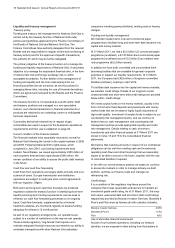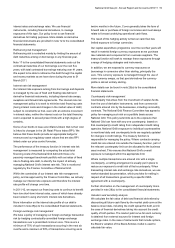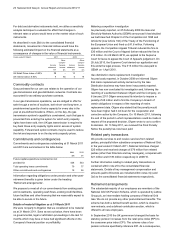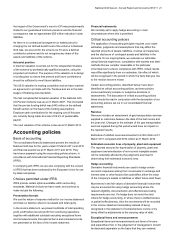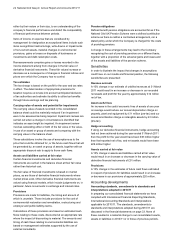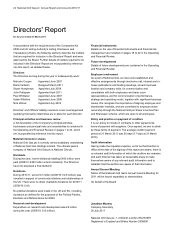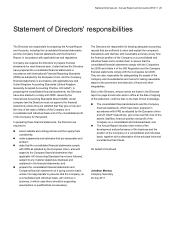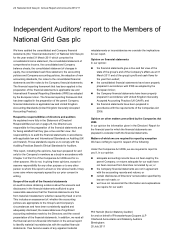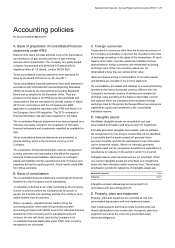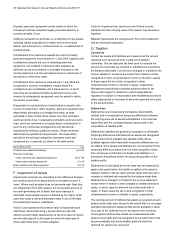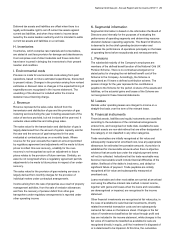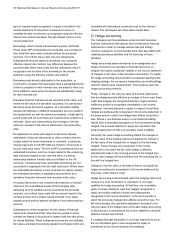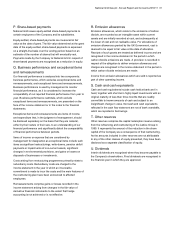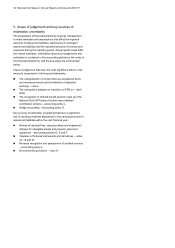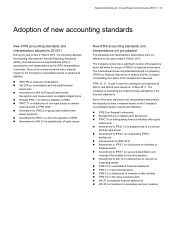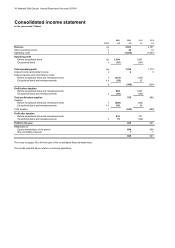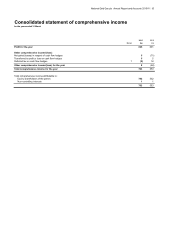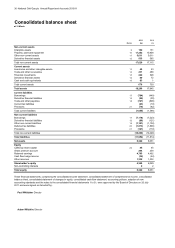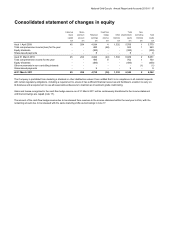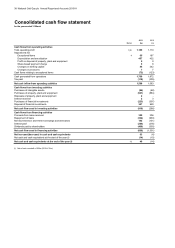National Grid 2011 Annual Report Download - page 30
Download and view the complete annual report
Please find page 30 of the 2011 National Grid annual report below. You can navigate through the pages in the report by either clicking on the pages listed below, or by using the keyword search tool below to find specific information within the annual report.
28 National Grid Gas plc Annual Report and Accounts 2010/11
Property, plant and equipment include assets in which the
Company’s interest comprises legally protected statutory or
contractual rights of use.
Additions represent the purchase or construction of new assets,
including capital expenditure for safety and environmental
assets, and extensions to, enhancements to, or replacement of
existing assets.
Contributions from customers towards the cost of property,
plant and equipment received prior to 1 July 2009, together with
contributions towards the cost of relocating plant and
equipment, are included in trade and other payables as
deferred income and credited on a straight-line basis to the
income statement over the estimated economic useful lives of
the assets to which they relate.
Contributions from customers received post 1 July 2009 are
recognised in revenue immediately, except where the
contributions are consideration for a future service, in which
case they are recognised initially as deferred income and
revenue is subsequently recognised over the period in which
the service is provided.
Depreciation is not provided on freehold land or assets in the
course of construction. Other property, plant and equipment are
depreciated, principally on a straight-line basis, at rates
estimated to write off their book values over their estimated
useful economic lives. In assessing estimated useful economic
lives, which are reviewed on a regular basis, consideration is
given to any contractual arrangements and operational
requirements relating to particular assets. Unless otherwise
determined by operational requirements, the depreciation
periods for the principal categories of property, plant and
equipment are, in general, as shown in the table below:
Depreciation periods Years
Freehold and leasehold buildings up to 50
Plant and machinery
– mains, services and regulating equipment 30 to 100
– meters and metering equipment 5 to 18
Motor vehicles and office equipment 3 to 10
F. Impairment of assets
Impairments of assets are calculated as the difference between
the carrying value of the asset and its recoverable amount, if
lower. Where such an asset does not generate cash flows that
are independent from other assets, the recoverable amount of
the cash-generating unit to which that asset belongs is
estimated. Recoverable amount is defined as the higher of fair
value less costs to sell and estimated value in use at the date
the impairment review is undertaken.
Value in use represents the present value of expected future
cash flows, discounted using a pre-tax discount rate that
reflects current market assessments of the time value of money
and the risks specific to the asset for which the estimates of
future cash flows have not been adjusted.
Tests for impairment are carried out only if there is some
indication that the carrying value of the assets may have been
impaired.
Material impairments are recognised in the income statement
and are disclosed separately.
G. Taxation
Current tax
Current tax assets and liabilities are measured at the amount
expected to be recovered from or paid to the taxation
authorities. The tax rates and tax laws used to compute the
amount are those that are enacted or substantively enacted by
the balance sheet date. Current tax is charged or credited to the
income statement, except to the extent that it relates to items
recognised in other comprehensive income or directly in equity.
In these cases the tax is also recognised in other
comprehensive income or directly in equity, respectively.
Management periodically evaluates positions taken in tax
returns with respect to situations in which applicable tax
regulation is subject to interpretation and establishes provisions
where appropriate on the basis of amounts expected to be paid
to the tax authorities.
Deferred tax
Deferred tax is provided using the balance sheet liability
method and is recognised on temporary differences between
the carrying amounts of assets and liabilities in the financial
statements and the corresponding tax bases used in the
computation of taxable profit.
Deferred tax liabilities are generally recognised on all taxable
temporary differences and deferred tax assets are recognised
to the extent that is probable that taxable profits will be
available against which deductible temporary differences can
be utilised. Such assets and liabilities are not recognised if the
temporary difference arises from the initial recognition (other
than a business combination) of assets and liabilities in a
transaction that affects neither the accounting profits nor the
taxable profits.
Deferred tax is calculated at the tax rates that are expected to
apply in the period when the liability is settled or the asset is
realised, based on the tax rates (and tax laws) that have been
enacted or substantively enacted by the balance sheet date.
Deferred tax is charged or credited to the income statement,
except where it relates to items charged or credited directly to
equity, in which case the deferred tax is also dealt with in
equity. In these cases the tax is also recognised in other
comprehensive income or directly in equity, respectively.
The carrying amount of deferred tax assets is reviewed at each
balance sheet date and reduced to the extent that it is no longer
probable that sufficient taxable profits will be available to allow
all or part of the deferred income tax asset to be recovered.
Unrecognised deferred tax assets are reassessed at each
balance sheet date and are recognised to the extent that it has
become probable that future taxable profit will allow the
deferred tax asset to be recovered.


